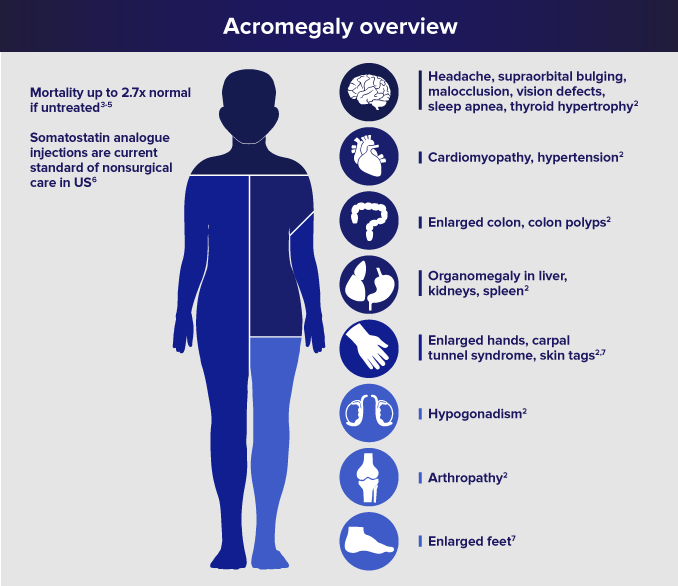Acromegaly Disease Overview:
Acromegaly Disease is a rare but impactful endocrine disorder characterized by the excessive production of growth hormone (GH) in adults. This condition usually results from a noncancerous tumor of the pituitary gland, known as a pituitary adenoma. The elevated levels of GH lead to an abnormal overgrowth of bones and tissues, particularly in the hands, feet, and face. Acromegaly often develops gradually, and its subtle onset can make early diagnosis challenging. Despite its rarity, the long-term consequences of untreated acromegaly can be severe, affecting various organs and systems in the body. Timely detection and intervention are crucial in managing this condition and preventing complications. This introduction provides a glimpse into the key aspects of acromegaly, from its underlying causes to its potential impact on overall health.
Acromegaly treatment options:
Acromegaly, a rare hormonal disorder, is caused by an excess of growth hormone in the body. This chronic condition, characterized by abnormal growth of the hands, feet, and facial features, requires comprehensive and timely treatment to manage symptoms effectively and prevent long-term complications. Over the years, medical science has made significant advancements in the treatment of acromegaly, offering patients a range of options to improve their quality of life.
- Medications:
The primary treatment for acromegaly involves systemic medication to reduce the excessive production of growth hormone. These medications include:
- Somatostatin analogs: These drugs suppress the release of growth hormone from the pituitary gland. Octreotide and lanreotide are the commonly prescribed somatostatin analogs.
- Growth hormone receptor antagonists: Pegvisomant, a growth hormone receptor antagonist, blocks the binding of growth hormone to its receptors, effectively reducing the symptoms of acromegaly.
- Dopamine agonists: Cabergoline and bromocriptine, typically used to treat other conditions like Parkinson’s disease, can also help normalize growth hormone levels in acromegaly patients.
- Surgery:
Surgical intervention is often recommended when medications fail to adequately control the symptoms or when there is a tumor pressing on nearby structures. The two primary surgical options for acromegaly treatment are:
- Transsphenoidal surgery: This minimally invasive procedure involves accessing the pituitary gland through the nose or upper lip to remove the tumor causing excess growth hormone production.
- Transcranial surgery: In cases where the tumor is large or complicated, transcranial surgery may be necessary. This procedure requires a craniotomy to access and remove the tumor.
- Radiation therapy:
Radiation therapy is usually reserved for cases where medication and surgery have not provided satisfactory results. It involves the use of high-energy beams to target and destroy tumor cells, ultimately reducing growth hormone production. Radiation therapy may take months or even years to effectively normalize hormone levels.
Browse In-depth Research Report on Acromegaly Disease:
https://www.diseaselandscape.com/autoimmune/acromegaly-market-regulatory-landscape
Acromegaly Disease Market Competitors Listed Below are Revolutionizing Healthcare with Innovative Diagnostic Inventions:
Blood Test:
- Klein Tools, Inc.
- Bioassay Technology Laboratory
- RayBiotech Life, Inc.
- Enzo Life Sciences, Inc.,
- Eagle Biosciences, Inc.
Imaging Test:
- Siemens Healthineers
- Med Imaging Solutions
- Canon Medical Systems Corporation
- Radiance Imaging System
- Ultrascan Diagnostics
- Diagnotech Corporation
Other Tests:
- Pro Scope System
- Fujifilm Holdings America Corporation
- Steris Plc
Acromegaly diagnosis:
Accurate and timely diagnosis of acromegaly is crucial for initiating appropriate treatment and preventing further complications. While the symptoms of acromegaly can vary widely among individuals, a combination of medical history, physical examination, and diagnostic tests can help confirm the presence of the condition.
- Medical history:
During the diagnosis process, doctors will inquire about the patient’s medical history, paying particular attention to physical changes, such as enlargement of extremities or changes in facial features, as well as any associated symptoms.
- Physical examination:
A comprehensive physical examination will be conducted to assess the patient’s overall health and to look for physical manifestations of acromegaly, such as enlarged hands and feet, facial changes, and excessive sweating.
- Diagnostic tests:
To confirm the diagnosis of acromegaly, the following tests are commonly used:
- Insulin-like growth factor 1 (IGF-1) test: This blood test measures the level of IGF-1, a hormone that reflects the amount of growth hormone in the body. Elevated levels of IGF-1 can indicate the presence of acromegaly.
- Oral glucose tolerance test (OGTT): In this test, the patient consumes a controlled amount of glucose, and blood samples are taken at regular intervals to measure growth hormone levels. In patients with acromegaly, growth hormone levels fail to suppress, even after glucose consumption.
- Magnetic resonance imaging (MRI): MRI scans of the brain are crucial in identifying the presence and location of pituitary tumors associated with acromegaly. These images provide valuable information for surgical planning.
Epidemiological Insights:
While acromegaly is categorized as a rare condition, recent improvements in diagnostic methodologies and heightened awareness have facilitated more precise prevalence estimates. Currently, it is estimated to affect approximately 60 cases per million people, providing a clearer perspective on the scope of the condition and its implications for those affected.
Assessment of Therapeutic Development:
The landscape of acromegaly treatments presents a promising panorama, featuring a diverse range of therapies at various stages of development. This signals optimism for the prospect of enhanced and more precisely targeted treatments in the foreseeable future. The evolving pipeline underscores the ongoing commitment to advancing therapeutic options for individuals grappling with acromegaly.
Acromegaly symptoms:
Acromegaly is characterized by distinct physical changes and symptoms that develop gradually over time. The excessive growth hormone production in acromegaly leads to various systemic effects, impacting multiple organs and systems in the body. Common symptoms of acromegaly include:
- Enlarged hands and feet: A classic symptom of acromegaly is the progressive enlargement of the hands and feet. This can lead to difficulty finding shoes or rings that fit and may cause joint pain and limited mobility.
- Facial changes: Overgrowth of bones and tissues in the face can result in prominent features, including an enlarged nose, protruding jaw, and thickened lips. Some individuals may also experience dental problems or changes in vision due to pressure on the optic nerves.
- Joint pain: Acromegaly can lead to the growth of abnormal bone tissue, causing joint pain and stiffness. This can impair mobility and result in decreased quality of life.
- Enlarged organs: The excessive growth hormone production in acromegaly can cause enlargement of internal organs, such as the heart, liver, and spleen. This enlargement can lead to cardiovascular complications and other systemic issues.
- Excessive sweating and oily skin: Acromegaly affects the body’s regulation of sweat production, leading to excessive sweating and oily skin, particularly in the palms and soles of the feet.
Growth hormone excess:
Growth hormone is a vital hormone responsible for regulating growth and metabolism in the body. However, when the production of growth hormone exceeds normal levels, as in the case of acromegaly, it can have significant negative effects on various physiological processes.
- Skeletal system:
Excess growth hormone in acromegaly can cause the bones and cartilage to enlarge, leading to changes in skeletal structure, particularly in the hands, feet, and facial bones. Over time, this can result in joint pain, limited mobility, and an increased risk of osteoarthritis.
- Cardiovascular system:
The cardiovascular system is significantly affected by excess growth hormone. Acromegaly patients are at an increased risk of developing hypertension, cardiomyopathy, and arrhythmias. The enlargement of the heart and blood vessels can lead to impaired heart function and an increased risk of heart failure.
- Endocrine system:
Acromegaly impacts the function of the endocrine system. The excessive growth hormone production can lead to insulin resistance, increasing the risk of developing type 2 diabetes. It can also disrupt the normal production and regulation of other hormones in the body.
- Metabolic effects:
Excess growth hormone in acromegaly can have a range of metabolic effects, including increased protein breakdown, impaired glucose utilization, and altered lipid metabolism. These metabolic abnormalities can result in weight gain, glucose intolerance, and dyslipidemia.
Future developments in acromegaly treatment
Continuous research and advancements in medical science offer hope for the future of acromegaly treatment. Some potential developments include:
- Targeted therapies: Researchers are exploring the use of targeted therapies to inhibit the growth of pituitary tumors associated with acromegaly. These therapies aim to disrupt specific molecular pathways involved in tumor growth.
- Gene therapy: Gene therapy holds promise for the treatment of acromegaly by targeting the genes responsible for excessive growth hormone production. By modifying these genes, medical professionals may be able to regulate growth hormone secretion effectively.
- Improved medical imaging techniques: Advancements in medical imaging, such as high-resolution MRI and positron emission tomography (PET), may enhance the detection and localization of pituitary tumors, improving surgical outcomes and treatment efficacy.
As research continues and technology advances, the future holds potential breakthroughs in the diagnosis and treatment of acromegaly. These developments may provide new treatment options and improved outcomes for individuals affected by this challenging condition.
Conclusion:
Acromegaly stands as a distinctive and consequential endocrine disorder, marked by the persistent overproduction of growth hormone in adults. The underlying culprit, often a benign pituitary adenoma, triggers a cascade of effects leading to the abnormal growth of bones and tissues. The insidious nature of acromegaly complicates early detection, necessitating heightened awareness among healthcare professionals and the general public. Untreated, this condition can have profound and systemic consequences, affecting not only physical appearance but also impacting the function of vital organs.
Browse Through More Autoimmune Disease Research Reports:
For More Related Reports:
Decoding the Complexity of Parkinson’s Disease: An In-Depth Exploration
Current Research and Clinical Trials in Cardiomyopathy Disease: Trends Unveiled
Delving into the Latest Breakthroughs in Alzheimer’s Disease Research: A Ray of Optimism
Defying the Odds: Global Perspectives on Multiple System Atrophy (MSA) Disease
Unraveling the Enigma of Crohn’s Disease: Causes, Symptoms, and Treatment Insights







